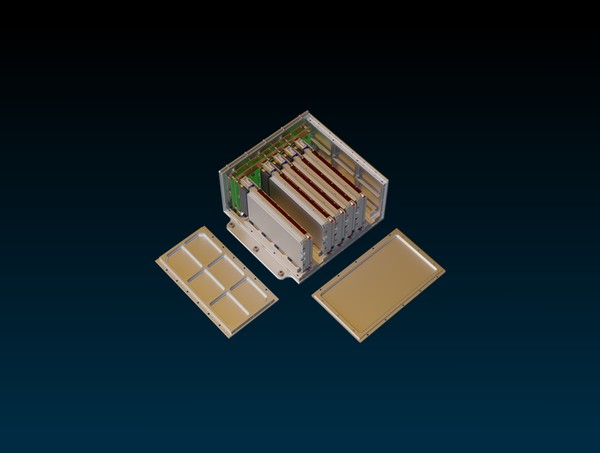Procuring SpaceVPX compliant technology from the commercial market is becoming increasingly interesting for a wide range of stakeholders.
The emerging standard has found support and uses across a variety of application areas, and its proponents believe this is resulting in more streamlined and secure system development.
In this article we discuss the standard and share details of a range of space hardware that is compliant with it.
If you’re familiar with the SpaceVPX standard and would instead like to skip straight down to the information about compliant products, please click here.
The SpaceVPX standard
SpaceVPX is an emerging hardware standard that applies to avionics boards and satellite chassis. It is also known as VITA-78, where VITA stands for VMEbus (VersaModular Eurocard bus) International Trade Association, and was developed according to the Next Generation Space Interconnect Standard (NGSIS).
It was created to bring greater alignment to the manufacture of high-performance computing platforms for space applications.
Open standards have been used by both hardware and software manufacturers for many years. Their proponents believe that they make development more efficient and enhance interoperability across supply chains, improving the quality and cost-effectiveness of products brought to market.
SpaceVPX leverages the OpenVPX (VITA 65.0) architecture. It includes profile-level “building blocks” that are modular (for simplified design and iterative development of more complex systems) and a standardized slot profile to ensure third-party interoperability.
Interconnected SpaceVPX compliant subsystems are built up using plug-in cards (PICs). The PICs are created according to the slot, module (or protocol), and backplane profiles the standard specifies.
In space missions, SpaceVPX systems are designed to ensure greater bandwidth and fault tolerance. And by standardizing interconnects with an open architecture, suppliers can develop products that can more easily be utilized in satellite designs and digital engineering processes alongside other components.
The SpaceVPXLite (VITA-78.1) standard
SpaceVPXLite is another emerging standard that satellite designers are paying more attention to. It is a derivative of the higher level SpaceVPX standard and is utilized in the fabrication of modules for smaller CubeSats.
The Lite version of the open standard is mainly concerned with 3U systems and has fewer backplane options compared to the VITA-78 version.
The aim is to reduce the complexity, interconnect redundancy, and engineering overhead for smaller and less powerful satellites. It instead places greater focus on the support of the data, utility, and control planes in the system.
SpaceVPX compliant products
In the list below we have included a variety of products that the suppliers have stated are SpaceVPX compliant. You can click on any of the boxes to open a page with more detail on the system that you are interested in.
From these pages you can then submit requests for quotes, documents, or further information by the supplier, and we’ll handle the request on your behalf (find out more about how this works here).
If you want to shortcut this process, or need some assistance refining your requirements, you can instead rapidly submit an open tender and our expert procurement team will get back to you ASAP.
The Ibeos EDGE-X Payload Processor is a radiation-tolerant system providing on-board processing power ranging from 300 GFLOPS to >1 TFLOPS. A mix of serial interfaces, for communicating with different bus and payload assemblies, are available along with a range of custom configurations.
Radiation-tolerant EDGE payload processors provide on-board processing power ranging from 300 GFLOPS to >1 TFLOPS. Available in 1U and 3U form factors, and featuring 4 ARM cores with up to 2 GHz clock speed and 256 GPU cores with up to xyz clock speed.
The Novo Space SBC002AV Single Board Computer has a Zynq Ultrascale+ with 4GB ECC-protected SDRAM & is compatible with the Vita 78 SpaceVPX standard.
The Space Core Odyssey-MOD-L3 is an OpenVPX radiation-hardened and tolerant modular CPU designed for MEO and GEO satellite applications. It is based on 32-bits LEON3-FT SPARC V8 dual-core Processor, SRAM, SDRAM, dual FLASH memory for executive allocation, and a PROM device devoted to Bootloader allocation. The Odyssey is specially developed under the 3U OpenVPX form-factor focus on system reconfiguration based on specific ANSI VITA daughter cards.
The RAD5545™ SpaceVPX single-board computer (SBC) integrates a version 1.2 RAD5545 system-on-chip (SoC) processor, with volatile & non-volatile memory, on a 6U-220 format module, compliant to the ANSI/VITA 78.00 SpaceVPX standard. Can operate as payload or system controller in a SpaceVPX backplane.
The ADM-VA601 is a 6U Space VPX reference platform for the AMD Versal AI Core XQRVC1902 Adaptable SoC platform for Space 2.0
The Trident Systems MultiFunction RF Electronics Unit & On-Board Processor (MFREU) is an integrated unit designed for space applications. It is a complete software defined radio (SDR), processor and data storage unit built on Trident’s VPX modules suitable for a wide range of mission applications. It is built with an EMI/EMC hardened chassis, integrated power supplies, and flexible I/O.
Thanks for reading! If you need any further help identifying the right SpaceVPX compliant system for your specific needs, please share your specifications with us and we’ll use our global network of suppliers to find options.
Have you noticed that your company isn’t included in this article?
Click here to find out the benefits of claiming your free profile on satsearch.
Once your pages are live, just send us an email and we can discuss showcasing your products to the global space engineering community on this page.








